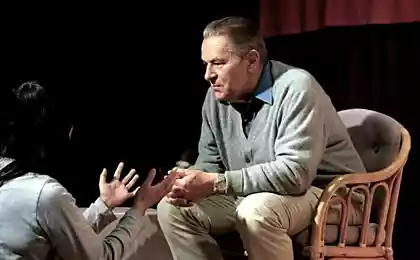466
Features of the human psyche, about which the magicians knew before scientists

Sorcerers and magicians test the limits of human perception and its nature. It is therefore not surprising that today's cognitive experts reveal traits of mind, which sorcerers and magicians have understood (and used) for centuries.
A closer acquaintance with many books about magic and witchcraft, published in the 16th century, allows you to learn about these hunches and insights that are only now making their way into the scientific literature.
1. Don't look now, but...Magicians have long used subtle eye movements to manipulate the attention of their viewers. Published in 1909 the book "Art of magic" (The Art of Magic) by T. Nelson downs (T. Nelson Downs) and John Hilliard (John Northern Hilliard) was emphasized: "needless to say" that at the time of submission of secret maneuver "eyes by even for a moment should not be directed to the right hand" involved in the performance of the focus.
"If the performer will forget about this rule," they warned, "the audience will immediately begin to suspect" that there was a corresponding movement.
In recent years, the effect of "perception of opinion" that in all things, from attention to social cognition has been the subject of numerous psychological studies. Not surprisingly, the magic proved to be a useful experimental tool.
For example, in his article published in 2009 in the journal Visual Cognition, researchers at the University of Durham (University of Durham) undertook a study of how MAG influenced the attention of 32 spectators during a demonstration of tricks.
And, indeed, the authors found that "participants spent less time looking at the critical hand when the magician was used in order to distract from her their attention." Downs and Hilliard ahead of them in this regard for a century.
2. What's the difference?Another topic causing heated debates in the past two decades, specialists in the cognitive Sciences. We are talking about "blindness in relation to the substitution of" (change blindness), or, as they call this phenomenon the experts Daniel Simons (Daniel Simons) and Ronald Rensink (Ronald Rensink), about the "amazing human inability to see significant changes that in normal circumstances it is easy to notice".
In one representative experiment, the researcher stopped pedestrians on a College campus and asked them for directions to a certain place. Then this conversation for a short time was interrupted by two people carrying a large door, and during this short time the first researcher who raised the question, was replaced by a completely different person.
More than half of cases pedestrians, showing the direction, did not notice that their companion has turned into a completely different person.
Of course, wizards and magicians have gotten to it first. In the field of card magic, for example, many methods are based on minor visual differences, which remain almost invisible even to an observer located at a close distance.
Some tricks are used, two similar card — eight of spades and eight of clubs, which, for instance, must be changed, often quite brazenly. Perhaps the earliest mention about this particular principle appeared in August Roterberg (August Roterberg) "Card tricks of a new era" (New Era Card Tricks), published in 1897.
3. Choose a side dish, any garnered encourage free choice is one of the oldest funds in the possession of wizards and magicians. Just think about the endless number of various techniques for imposing upon certain cards from the deck while maintaining the illusion of free choice.
This method exists, at least since 1584, when Reginald Scott (Reginald Scott) published the book "Discovery of witchcraft" (The discoverie of witchcraft), which is the early English work containing a detailed description of the different kinds of tricks.
Nevertheless, the knowledge that irrelevant, invisible factors can influence our decisions in predictable and unnoticed way only now receiving due attention of the representatives of the academic world, especially those involved in behavioral Economics. This area produces a steady stream of bestsellers, and one of her ancestors, Daniel Kahneman (Daniel Kahneman) in 2002 received the Nobel prize in Economics.
It has also become popular among policy experts as Cass Sunstein (Cass Sunstein). He strongly advocated the use of methods of behavioral Economics to the secret "nudging" citizens to some of the decisions — whether it's putting money aside for retirement or choosing better foods.
4. Where were you at that moment, when the elephant disappeared?Imperfect memory can become the best friend of the magician. To the public magic shows are often more impressive — and impossible — with a retrospective look at them.
As noted in 1918, one writer on magic publication the Magic Circular, the memory lapses to the audience, "we owe half of cases associated with wonderful stories about things that never happened, but which nevertheless help to strengthen our reputation".
Some artists of this genre, in fact, have the ability to stimulate an exaggerated memory, and they do it in such a way that I don't have the opportunity to speak here.
Our main trend is to create inaccurate memories of an event — psychologists often call this phenomenon "reconstructive memory," and she recently attracted more attention, especially regarding its impact on the testimony of witnesses in the American judicial system.
Psychologist Elizabeth Loftus (Elizabeth Loftus) found, for example, that "the questions posed directly after the event, is able to introduce new — and not necessarily correct — information which is then added" to the memory of the witness.
5. The audience is always right to sojaleniyu shortcomings don't always work for the benefit of the magician. Master practitioners of the genre know too well that often any spectator interrupts the focus and results in an incorrect explanation, specific numbers (the phrase "It's in the hole" and "Magnets!" are regular favorites).
Even when such kind of ill-conceived assertions do not explain anything (which attitude can be a magnet to the disappearance of coins?), this is sometimes enough to ruin the public impression of the focus.
Such episodes are used as textbook examples of what psychologists Frank Keil (Frank Keil), and rozenblit, Leonid (Leonid Rosenblit) called "the illusion of depth of understanding" or feeling that we "understand complex phenomena with greater precision, consistency and depth than we usually do".
As they wrote in an article published in 2002 in the journal Cognitive Science, "laypeople... usually do not notice the incompetence of their theories", and this is partly due to the fact that they "rarely have to provide a full explanation of most of those phenomena, which, they think, they understand." And I still claim that it was the magnets.
Robert Herritt (Robert Herritt)
source: nlo-mir.ru
Source: /users/1077
How to clean the kitchen without household chemicals
Classification of emotions - in anticipation of anger























